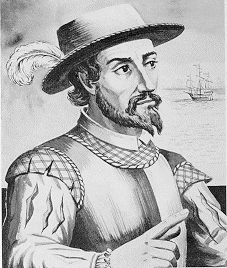|
Juan Ponce de León Spanish Explorer and Conqueror 1460-1521 Juan Ponce de León was born at San Servas in the province of Campos in 1460. There is no record of his parents although it is known that he descended from the ancient family of León through the marriage of one of the Ponces to Doña Aldonza de León, a daughter of Alfonso IX. As a youngster Ponce de León served as page to Pedro Nuñuz de Guzmán, later the tutor of the brother of Charles V, the Infante Don Fernando. On Columbus' second voyage in 1493, Ponce sailed to Hispaniola.
Although he had subdued the natives, he was soon removed from office, but not until he had amassed a considerable fortune. During this time stories were prevalent of a famous spring with powers to restore youth and vigour to those who drank the water. Maybe the Spaniards misunderstood the Indians tales because they got the idea that the fountain was situated on an island called Bimini which lay north of Hispaniola. On 23 February, 1512, Ponce obtained from Charles V, a patent giving him jurisdiction over the island of Bimini for life, and bestowing upon him the title of Adelantado. On 3 March, 1513, he set out from San German (Porto Rico) with three ships, fitted out at his own expense. Setting his course in a northwesterly direction he reached Guanahani eleven days later where Columbus had first spotted land. Continuing his way, on Easter Sunday, 27 March, he came within sight of the coast which he named "Pascua de Florida," or feast of flowers, in honor of the day. On 2 April he landed at a spot a little to the north of the present site of St. Augustine and formally took possession in the name of the Crown. He then turned back, following the coast to its southern extremity and up the west coast to latitude 27°30', and then returned to Porto Rico. During this trip he had several encounters with the natives, who showed great courage and determination in their attacks, which probably accounts for the fact that Ponce did not attempt to found a settlement or penetrate into the interior in search of the treasure which was believed to be hidden there. Although his first voyage had been without result as far as the acquisition of gold and slaves, and the discovery of the "fountain of youth" were concerned, Ponce determined to secure possession of his new discovery. Through his friend, Pedro Nuñez de Guzmán, he secured a second grant dated 27 September, 1514, which gave him power to settle the Island of Bimini and the Island of Florida, for such he thought Florida to be. In 1521 he set out with two ships and landing upon the Florida coast, just where, it is not known, he was furiously attacked by the natives while he was building houses for his settlers. Wounded and driven off the land he set sail for Cuba where he died from the wound. An important discovery, unrecognized by Ponce de León, was the existence of a river in the ocean later called the Gulf Stream. Although they had the wind on their side, the powerful Gulf Stream pushed them back. Two of the ships anchored, but one was carried away. The pilot, Anton de Alaminos, did understand the importance of the discovery. By riding the current, the ships could be carried to a point where the winds would carry them back to Spain. Six years later, Alaminos proved his theory by bringing treasure from Mexico to the King of Spain with the aid of the Gulf Stream. This became the route of the later treasure ships. |
All rights reserved. For details and contact information: See License Agreement, Copyright Notice. |
 When Nicolás Ovando came to Hispaniola in 1502 as governor, he found the natives in a state of revolt, and in the war which followed Ponce rendered such valuable services that he was appointed Ovando's lieutenant with headquarters in a town in the eastern part of the island. While here, he heard from the Indians that there was much wealth in the neighboring Island of Buriquien (Porto Rico), and he obtained permission to visit it in 1508, where he discovered many riches. For his work in this expedition he was appointed Adelantado or Governor of Boriquien.
When Nicolás Ovando came to Hispaniola in 1502 as governor, he found the natives in a state of revolt, and in the war which followed Ponce rendered such valuable services that he was appointed Ovando's lieutenant with headquarters in a town in the eastern part of the island. While here, he heard from the Indians that there was much wealth in the neighboring Island of Buriquien (Porto Rico), and he obtained permission to visit it in 1508, where he discovered many riches. For his work in this expedition he was appointed Adelantado or Governor of Boriquien.